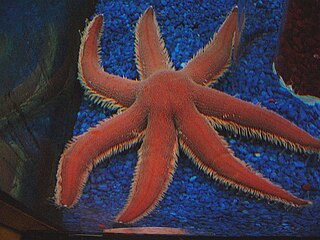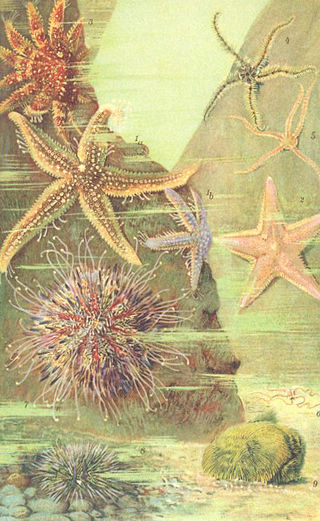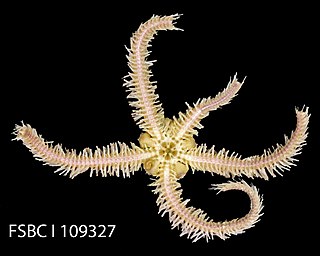
An echinoderm is any member of the phylum Echinodermata. The adults are recognisable by their radial symmetry, and include starfish, brittle stars, sea urchins, sand dollars, and sea cucumbers, as well as the sea lilies or "stone lilies". Adult echinoderms are found on the sea bed at every ocean depth, from the intertidal zone to the abyssal zone. The phylum contains about 7,000 living species, making it the second-largest grouping of deuterostomes, after the chordates. Echinoderms are the largest entirely marine phylum. The first definitive echinoderms appeared near the start of the Cambrian.

Starfish or sea stars are star-shaped echinoderms belonging to the class Asteroidea. Common usage frequently finds these names being also applied to ophiuroids, which are correctly referred to as brittle stars or basket stars. Starfish are also known as asteroids due to being in the class Asteroidea. About 1,900 species of starfish live on the seabed in all the world's oceans, from warm, tropical zones to frigid, polar regions. They are found from the intertidal zone down to abyssal depths, at 6,000 m (20,000 ft) below the surface.

Brittle stars, serpent stars, or ophiuroids are echinoderms in the class Ophiuroidea, closely related to starfish. They crawl across the sea floor using their flexible arms for locomotion. The ophiuroids generally have five long, slender, whip-like arms which may reach up to 60 cm (24 in) in length on the largest specimens.

Cucumaria miniata is a species of sea cucumber. It is commonly known as the orange sea cucumber or red sea cucumber due to its striking color. This northeast Pacific species is often found wedged in between rocks or crevices at the coast or on docks and can generally be identified by its orange bushy tentacles protruding above the substrate.

Novocrania anomala is a species of brachiopod found offshore in the eastern Atlantic Ocean.

Luidia ciliaris, the seven-armed sea star, is a species of sea star (starfish) in the family Luidiidae. It is found in the eastern Atlantic Ocean and the Mediterranean Sea.

Ophiocomina nigra, commonly known as the black brittle star or black serpent star, is a species of marine invertebrate in the order Ophiurida. It occurs in the north-eastern Atlantic Ocean, the North Sea and the Mediterranean Sea.
Ophiothrix suensoni, Suenson's brittle star or the sponge brittle star, is a species of marine invertebrate in the order Ophiurida. It is found in the Caribbean Sea and Gulf of Mexico. It is included in the subgenus Acanthophiothrix making its full scientific name Ophiothrix (Acanthophiothrix) suensoni.

Ophiocoma scolopendrina is a species of brittle star belonging to the family Ophiocomidae. Restricted to life in the intertidal, they live in the Indo-Pacific. They can typically be found within crevices or beneath borders on intertidal reef platforms. Unlike other Ophiocoma brittle stars, they are known for their unique way of surface-film feeding, using their arms to sweep the sea surface and trap food. Regeneration of their arms are a vital component of their physiology, allowing them to efficiently surface-film feed. These stars also have the ability to reproduce throughout the year, and have been known to have symbiotic relationships with other organisms.

Ophiura albida is a species of brittle star in the order Ophiurida. It is typically found on the seabed in the north eastern Atlantic Ocean and in the Mediterranean Sea and is sometimes known as the serpent's table brittle star.

Ophionereis reticulata, the reticulated brittle star, is a brittle star in the family Ophionereididae. It is found in shallow parts of the western Atlantic, Caribbean Sea and Gulf of Mexico.

Amphiura filiformis is a species of brittle star belonging to the family Amphiuridae. It is found on the seabed in the north east Atlantic Ocean and adjoining seas to a depth of 200 metres (660 ft). It digs itself a shallow burrow in the sand and waves its arms in the water above to suspension feed on plankton.

Gorgonocephalus arcticus is a species of basket star in the class Ophiuroidea. The genus name comes from the Greek, gorgós meaning "dreaded" and cephalus meaning "head", and refers to the similarity between these echinoids and the Gorgon's head from Greek myth with its coiled serpents for hair.

Amphiura chiajei is a species of brittle star belonging to the family Amphiuridae. It is found in the northeastern Atlantic Ocean and adjoining seas to a depth of 1,000 metres (3,300 ft). It digs itself into the soft sediment of the seabed and raises its arms into the water above to suspension feed on plankton. It was first described by the British naturalist Edward Forbes in 1843, and was named for the Italian zoologist Stefano Delle Chiaje (1794–1860).

Ophiothrix angulata, the angular brittle star, is a species of marine invertebrate in the order Ophiurida. It is found in the warm waters of the western Atlantic Ocean, the Caribbean Sea and the Gulf of Mexico.

Ophiopholis aculeata, the crevice brittle star or daisy brittle star, is a species of brittle star in the family Ophiactidae. It has a circum-polar distribution and is found in the Arctic Ocean, the northern Atlantic Ocean and the northern Pacific.

Florometra serratissima is a species of crinoid or feather star in the family Antedonidae. It is found off the Pacific coast of North America, usually in deep water.
Ophiomusa is a genus of echinoderms belonging to the family Ophiolepididae that includes: sea urchins, sand dollars and sea cucumbers. Ophiurida are similar to starfish; they both have a central disc and five arms sprouting from the disc. One of the main distinguishing factors of an Ophiuroid is its arms; the arms of an Ophiurida are longer, thinner, and distinctly separated in comparison to those of a sea star.


















